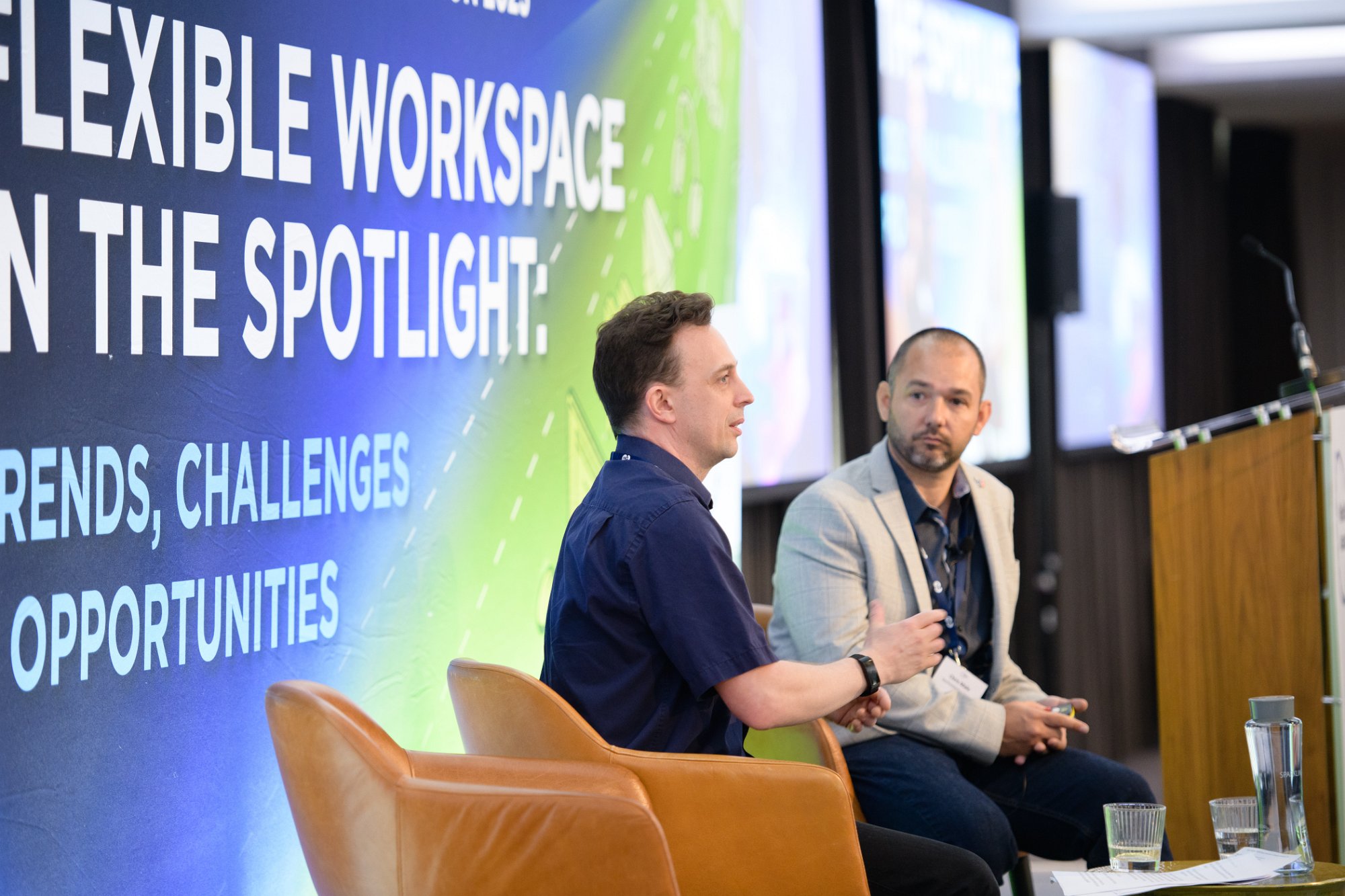
Creating a future proof technology strategy
At last week’s Flexible Space Association Conference and Exhibition, technologywithin’s Chris Male and Martin Whitaker (pictured below) led a break-out session on creating a technology strategy that delivers for clients and flexible workspace businesses. Here they set out thoughts and guidance on the topic.
It’s now been eight years since we were promised hover boards, power lacing trainers and the release of Jaws 19. This is of course according to the timelines from Back to the Future and while we could debate the many topics around time travel and Marty McFly we’ll instead use this blog to talk about looking to the future when it comes to your technology strategy and in particular the changes you can make now in order to help welcome whatever new challenges are waiting in the future.
The first thing to consider is that being one step ahead of technology and technological change means that you can avoid unforeseen costs, ensure strong levels of resilience in your services and maintain and grow even better levels of customer satisfaction. It is however tricky to get your mind out of the present and look forward to what the future might bring.

Technological change
So, what’s driving the need for technological change? Well, it’s your clients. Their behaviour and expectations are the key drivers for tech change. This can partly be down to the changes we saw resulting from the pandemic. The demand for hybrid working has meant that there’s been a decrease in average office size with our data telling us now that the average office is seven workstations. The requirements for different types of workspace, from day membership style coworking through to private call pods also means that your technology strategy needs to be flexible to keep up with the changes. It’s also interesting to note the type of client looking at flexspace is also changing. Corporate are continuing to rethink their building strategies and move into flex. Multinationals such as Vodafone and Deutsche Bank are downscaling their headquarters and looking for more flexibility.
Corporates are also more stringent about their security. In our research we found that 14% of users in our client’s buildings have their own VPN and firewall, showing that when they become flexible workspace users they want their own secure access to their company networks. They are also more likely to want you to meet the standards for protocols such as Cyber Essentials, another important issue you’ll need to consider.
Resilient and reliable connectivity
So, it’s time to look at the first of the topics to consider when building your technology strategy and that is connectivity. We delved into our records to look at the growth of bandwidth requirements from our clients from 2015 to the present day. What we saw was a 1800% growth in the average flexible workspace fibre internet order from an average of 100MB in 2015 to 1.8GB in 2023. Do we think that this rise will continue? Well here at technologywithin we have differing views. Some think it will continue to rise while others feel that it may plateau with the technology not advancing fast enough to merit another sharp increase in the bandwidth required (4K video has driven the rise and is now pretty standard with 8k on the very distant horizon). The likely scenario is that there will be some rise but not as fast as it has been.
What we are seeing more evidence of is an increased demand for higher quality connectivity. Five years ago the most popular bandwidth package would likely have been 30Mbps but it’s now 100Mbps (based on our clients data) and this seems to tally with what the wider flexible workspace sector is seeing.
Get the right infrastructure
So having established that you need to ensure you have the right connectivity, the next topic to consider is infrastructure. Our stats showing the increased need for more and better-quality bandwidth mean that operators are increasingly looking at larger fibre connections. However, increasing the fibre internet bandwidth to a workspace doesn’t automatically give you better connectivity. If you move from say 1GB to a 10GB connection you need to make sure you have the right network management, switches and wireless access points that can get the speed to where your clients need it.
This also applies to WiFi. While there have been many technological advances in how WiFi is now delivered there are still challenges. There are a few operators now that offer a completely wireless office and from our point of view we feel this that this strategy should be approached with caution. WiFi is a shared space and so there will always be some contention. It may offer the flexibility to work wherever you like in the building but we are finding that clients prefer to have complete control over their speed and a wired connection is the only way to achieve this (backed up by research into UK home WiFi speeds in comparison to wired ethernet). So, in short, put more wires in to ensure that you are able to plan for all eventualities whether that’s installing IoT sensors, boosting your meeting room usage or allowing you to reshape your space to create smaller or larger offices.
Software to enhance customer experience
Now we’ve covered connectivity and infrastructure, the final area to consider is software. Software is best thought of as the glue that binds everything together. It improves customer experience and the efficiency of your management teams. There are many software providers out there who can promise a range of different features to enhance your operation. Here’s our mini guide on what you should look out for.
- Choose software and services that integrate easily, an open API (Application Programming Interface) is the key for this and lets different pieces of software talk to each other.
- Select software that matches your growth plans. Think about where the pain points might be, things like your monthly billing run or access to licences, make sure that the software you choose can grow with you.
- It may seem like something that’s far off and not worth thinking about but consider AI and how it could enhance your services, will the software you choose adapt and integrate with it.
- Finally consider your clients increasing needs for ESG (Environmental, Social, Governance) information and how your software of choice can help with this.
In conclusion
Here’s our key takeaways:
Connectivity – Order larger fibre connections to keep up with increased demand and also ensure that you have back up lines for a resilient and stable service.
Infrastructure – Large fibre connectivity needs more infrastructure to deliver the performance your clients need, so make sure yours can handle the larger connections. Cabling is still key for offering flexibility and delivering high performance so make sure you put in more wires.
Software – Integration is key to easy management and a smooth customer experience, look for an open API approach.
As always if you’d like to discuss any of the subjects further with our team, get in touch with the team at technologywithin today.
2 June 2023
Return to News Page

